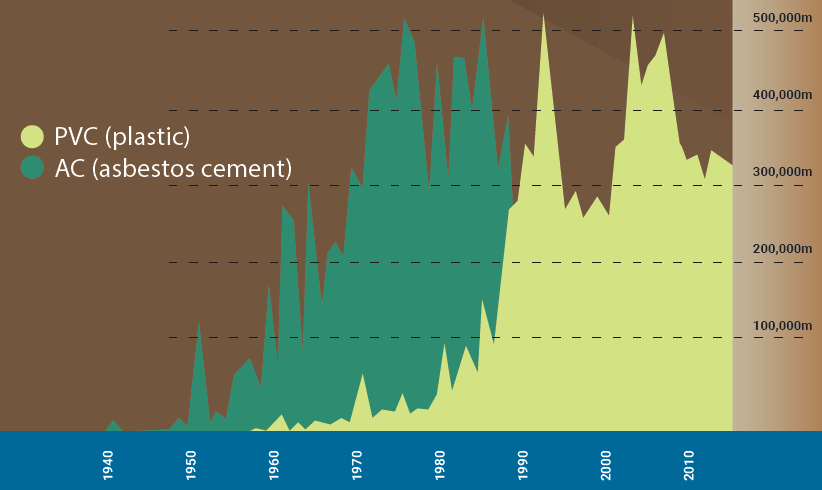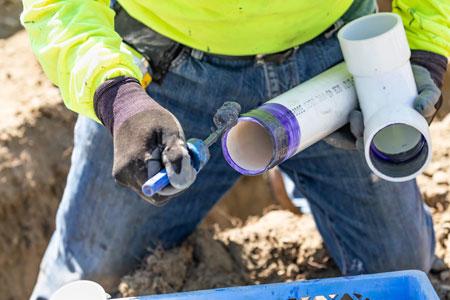A major report released by Infrastructure Australia today shows that regional and remote local governments struggle to fund roads and airports. In addition, addressing the problem of ageing water and sewerage infrastructure in Queensland is becoming a looming and urgent issue known as the infrastructure cliff.
In this piece written by LGAQ's Nathalie Cattaneo, we cover what the infrastructure cliff means for Queensland's water and sewerage services and how it might be approached.
Queensland’s water and sewer pipes are both very essential and very expensive.
The 75, 500 km of pipes make up the largest component of the $37 billion worth of water and sewerage infrastructure currently owned by the Queensland Local Governments. That complex network of pipes that exist somewhere in the depths below us is currently servicing over 4.3 million people across 370 communities.
It can be easy to overlook the value of pipes but as the ancient Romans knew, a good functioning water and sewerage system can take you from a small town in central Italy to one of the greatest empires encompassing most of continental Europe. Queensland’s ambitions may be more docile but the pressures and problems of maintaining a complex water system are no less relevant than they were 2000 years ago.
Not unlike ancient Rome, our water and sewerage system has some challenges. Whilst for the Romans it was lead poisoning, disease and general smelliness, Queensland’s challenges lie in the age and composition of the infrastructure.
Data by the Queensland Water Regional Alliances Program (QWRAP) has revealed that a significant component (29%) of current water and sewerage networks are composed of asbestos cement (AC) pipes installed between the 1960s to the 1990s (Fig. A). The median expected life for all the AC pipes was 70 years meaning a large cohort of mains is likely to require renewal over a similarly period in coming years.

Image: Over 22,000 km of asbestos cement (AC) water mains were installed between the 1960s and 90s leaving a cohort of pipes that will soon reach their expected life-time
Queensland’s networks saw rapid expansion in the decades following World War II creating a large amount of infrastructure that will come to the end of its useful life over a similarly short period in coming years.
Three independent modelling approaches predicted that the AC mains would suffer increasing failure rates over the next two decades peaking by the 2040s. Similar results were projected for sewer networks, which although typically younger than corresponding water schemes, are predicted to suffer a more rapid degradation.
This problem is further complicated by the continued expenditure on network expansion along with the hidden nature of existing networks, meaning the degradation of existing pipes is not obvious and ageing assets tend to only attract public and political attention during major incidents.
Modelling predicts that at a conservatively estimated replacement rate of 0.3% per annum, the ageing AC cohort alone would take over 170 years to replace!
All this brings us to a potential crisis point; the infrastructure cliff; the point at which assets begin to fail and need to be replaced.
In its report, the Queensland Water Regional Alliances Program (QWRAP) says bad decision making is the biggest risk to the network,
“The greatest potential to improve…is to avoid investments that unnecessarily inflate the future ‘cost-to serve’.
Rather a smarter approach to repair and maintenance will be essential to ensuring we avoid the direst perils of the infrastructure cliff,
“A considered approach to the need for increased monitoring, maintenance and rehabilitation of Queensland’s ageing in-ground assets can provide significant savings in coming years.”
“Postponing the investment steepens the slope of the investment curve that must ultimately be met…[and]… increases the odds of facing the high costs associated with water main breaks and other infrastructure failures. However, because it is not cost-effective to replace a pipe before, or even after, the first break a proactive approach to pipe asset management is crucial in determining the optimal time to replace a pipe”
This kind of approach saved the State Government and taxpayers more than $2 million last year when five councils (Bundaberg, Gympie, Fraser Coast, North and South Burnett) and QWRAP joined forced to tackle the problem of sewer maintenance.
The group put the mammoth task of relining their sewer networks up for tender through a joint procurement process. Realising they could also benefit, Cherbourg Aboriginal Shire Council plugged into the project; a collaboration that resulted in some surprising savings.
The joint procurement and a decision to reline the pipes rather than replace Cherbourg’s wastewater network saved a total of $2.6 million. Even without Cherbourg’s involvement in the arrangement it’s estimated to save councils more than $300, 000 in one year.
Arron Hieatt, LGAQ Principal advisor for water and sewerage infrastructure said the success of the project is promising for future endeavours.
“This success not only exemplifies how well a collaborative approach can work, it also highlights that you don’t always have to replace the asset; delaying it through smart interim measures can result in huge savings.” Mr. Hieatt said.
Whilst the cost of replacement for the network will still be huge, says QWRAP’s report, decision making will be critical,
“All methods seek to balance the need to maintain services and optimise the trade-off between replacement and repair…the point in time when replacement or rehabilitation becomes less expensive going forward than the costs of numerous unscheduled breaks and associated emergency repairs. This is a nuanced trade-off which varies from town-to-town.”
Its an approach that could have helped the Romans; some researchers believe lead poisoning is contributed to the eventual fall of the empire (but to be fair it was mostly those pesky barbarian tribes.)
Want to know more? listen to the podcast below to hear LGAQ CEO Greg Hallam chat with Maranoa Regional Council Councillor David Schefe and CEO of the Western Downs Regional Council Ross Musgrove about the looming water infrastructure crisis affecting basic water and sewerage services in Queensland.